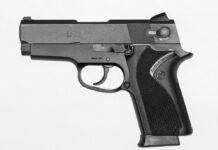9-Hole reviews runs their practical accuracy course with their “AK Alpha Trainer” stand-in. The ‘pistol’ is set up in a manner consistent with current Russian and general high performance AK users. The AK102/105 systems with 12.5″ barrels being used as general purpose carbines by Spetsnaz units. Accuracy is based on system capabilities and effective accuracy is too.
Josh and Henry, as usual, make several good point that I believe they can and should keep applying. Even going back to evaluate past systems with their more mature experiences.
One of the most important they illustrate here is, as they encounter the limits of the AK/optic combination, they do not conflate limitation with detrimental quality. A limit simply is, it is a data point among many to determine whether or not a particular system is suitable for a particular task. Can anything be done to change the system and alter the limit? Is that change reasonable?
50 Yard Shooters Criticizing 500 Yard Guns
50 yards is a long shot for some shooters. Many shooters in fact, perhaps even most shooters. This coincides with the fact that most shooters would never and will never have to contemplate a 50 yard shot in their lifetimes, even to save a life. The numbers and reality say that 10 yards and in is probably your gunfight. Unless you roll that Murphy’s Luck special, and then you get special circumstances.
Las Vegas, Route 91/Mandalay Bay, would be an example of special circumstances, a long distance complex ambush on a highly populated entertainment venue. How many home invasions, aggravated assaults, and common car jacking type crimes happened? How many “common” homicides?
But if you want a firearm to cover a swath of capabilities you have to state your limits with some realism. While an LEO would not have had a problem articulating the need to fire back into the window where Paddock was firing into the crowd from and suppressing him (despite suppression being an exceedingly rare tactic in LE), ability may have been another thing entirely. Even were a patrol rifle present and the rifle capable of making the 300+ yard shots if the shooter cannot the shooter should not.
Fact: Most carbines, including braced pistols, would be able to make that shot easily. Heck an MP5 or other shoulder fired 9mm properly sighted in could’ve put accurate fire on Paddock’s position. The shooter would determine effectiveness.
So just because a platform (rifle, optic, ammo, and shooter) didn’t hit the 8 small gongs 16 times in 40 shots at moderate to maximum effective range for most intermediate calibers, does not determine an ineffective or effective rifle. It does grant data points to consider for the platform and suggest changes if a platform has a deficiency.
Defining Effective Range
The maximum distance at which a weapon may be expected to be accurate and achieve the desired effect. –Dictionary of Military and Associated Terms. US Department of Defense 2005.
With rifles this is generally a 50-90% hit probability (either mechanical accuracy of the rifle/ammo or factoring in an average shooter) on a single man sized target, known as a point target, or a vehicle sized one, known as an area target.
If I hand you a a magazine and you can hit the target half the time, you are in your effective range for that repeating firearm. I specify repeating, a platform where follow up shots are expected/encouraged, because precision is a different application and has different parameters.
Under these parameters, the “AK Alpha Trainer” probably has a 500 yard effective range, perhaps 450 yards. Mathematically somewhere in that range is a specific distance based upon their exact current equipment and the atmospherics, but that is getting too technical and we need a broader answer.
I suspect a better optic for distance, an LPVO, would tighten up that hit probability to be more in line with the mechanical accuracy of the platform.
It’s all about the numbers.
I love Josh and Henry’s practical accuracy course. It presents highly valuable snapshot data. Those numbers, combined with others numbers, combined with accounted for variances, present a picture that can answer the yes or no question of whether any given firearm is a contender for your needs.



